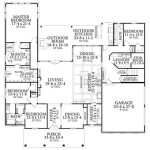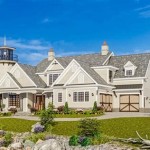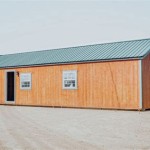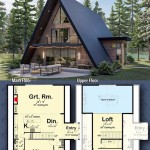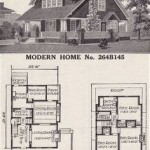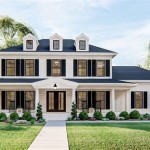Dog trot house plans, a distinctive style of architecture, are blueprints for constructing homes featuring a central breezeway, or “dog trot,” that connects two separate living spaces. Originating in the Southern United States during the 18th century, these designs were particularly suited to the region’s warm and humid climate, offering natural ventilation and comfortable living conditions.
Dog trot houses typically include two separate wings, each consisting of a room or rooms. The central breezeway, which runs perpendicular to these wings, creates a covered outdoor space that serves as a central gathering area, a dining space, or even an additional sleeping porch. This design not only provides cross-ventilation through the house, but also creates a shaded and protected outdoor living area.
In the following sections, we will delve into the history, architectural features, advantages, and considerations involved in designing and building dog trot houses, providing valuable insights for homeowners and architects alike.
When considering dog trot house plans, several key points are worth noting:
- Central breezeway for ventilation and outdoor living
- Two separate wings for living spaces
- Cross-ventilation through breezeway and windows
- Shaded outdoor space protected from elements
- Historical significance in Southern US architecture
- Energy efficiency due to natural ventilation
- Adaptable design for various climates and needs
- Outdoor living extension with screened porches or decks
- Customization options for size, style, and features
These elements contribute to the unique character and functionality of dog trot house plans.
Central breezeway for ventilation and outdoor living
The central breezeway, a defining feature of dog trot house plans, serves multiple functions that enhance both indoor and outdoor living:
- Natural ventilation:
The breezeway acts as a natural ventilation system, allowing air to flow freely through the house. This passive cooling strategy helps regulate indoor temperatures, reducing the need for air conditioning and creating a more comfortable living environment, especially in warm and humid climates.
- Cross-ventilation:
The breezeway facilitates cross-ventilation, drawing air through the house from opposite sides. This airflow helps remove stale air and introduce fresh air, improving indoor air quality and creating a healthier living space.
- Outdoor living extension:
The breezeway extends the living space outdoors, providing a shaded and protected area for relaxation, dining, or entertaining. This outdoor room can be further enhanced with screened porches or decks, creating a seamless transition between indoor and outdoor living.
- Social gathering space:
Historically, the breezeway served as a central gathering space for families and communities. It offered a shaded and comfortable area for socializing, storytelling, and other activities.
The central breezeway is a versatile and functional element that contributes significantly to the livability and charm of dog trot houses.
Two separate wings for living spaces
Dog trot house plans typically feature two separate wings for living spaces, offering several advantages:
- Privacy and separation
The two wings provide separate and private spaces for different activities or family members. This separation can be beneficial for creating dedicated areas for sleeping, working, or entertaining guests.
- Flexibility and adaptability
The separate wings allow for flexibility in design and use. Each wing can be customized to suit specific needs, such as the number of bedrooms, bathrooms, or the incorporation of additional features like fireplaces or built-in storage.
- Natural light and ventilation
With windows and doors on both sides of each wing, the separate living spaces benefit from ample natural light and cross-ventilation. This not only creates a brighter and more inviting interior but also promotes healthy indoor air quality.
- Historical authenticity
The two-wing design is a defining characteristic of traditional dog trot houses. Preserving this feature ensures the authenticity and historical charm of the home.
The separation of living spaces into two wings is a key element that contributes to the functionality, flexibility, and historical significance of dog trot house plans.
Cross-ventilation through breezeway and windows
Dog trot house plans incorporate strategic placement of windows and doors to maximize cross-ventilation, ensuring a comfortable and healthy indoor environment:
Breezeway as a central ventilation channel:
The central breezeway acts as a natural ventilation channel, allowing air to flow freely through the house. With windows and doors positioned on opposite sides of the breezeway, air can enter one side of the house, pass through the breezeway, and exit through the other side. This continuous airflow helps regulate indoor temperatures and removes stale air, creating a more comfortable and healthier living space.
Cross-ventilation through windows:
In addition to the breezeway, windows are strategically placed throughout the house to facilitate cross-ventilation. Windows on opposite walls of each room allow air to flow through, creating a cooling effect and improving indoor air quality. This passive cooling strategy reduces the reliance on air conditioning, resulting in energy savings and a more sustainable home.
Enhanced ventilation with screened porches:
Many dog trot house plans incorporate screened porches or verandas, which further enhance cross-ventilation. These outdoor spaces allow for increased airflow while keeping out insects and pests. Screened porches can be used as additional living areas during warmer months, providing a comfortable and well-ventilated space for relaxation or entertaining.
Historical significance of cross-ventilation:
The emphasis on cross-ventilation in dog trot house plans is not only practical but also rooted in historical significance. In the warm and humid climate of the Southern United States, where dog trot houses originated, cross-ventilation was essential for creating comfortable living conditions without the use of modern cooling systems. The design ensured a constant flow of fresh air, reducing indoor temperatures and improving the overall well-being of occupants.
Shaded outdoor space protected from elements
Dog trot house plans incorporate thoughtful design elements that create shaded outdoor spaces, offering protection from the sun, rain, and other weather conditions:
Deeply recessed breezeways:
The central breezeway in dog trot house plans is typically deeply recessed, providing ample shade from the sun. This recessed design ensures that the breezeway remains cool and comfortable, even during the hottest parts of the day. It creates a sheltered outdoor space where occupants can enjoy fresh air and natural ventilation without exposure to direct sunlight.
Overhanging roofs and porches:
Many dog trot house plans feature wide overhanging roofs and porches that extend beyond the breezeway. These architectural elements provide additional shade and protection from rain and wind. The covered porches create inviting outdoor living areas that can be used for relaxation, dining, or entertaining guests, regardless of the weather conditions.
Strategic placement of windows and doors:
Windows and doors are strategically positioned in dog trot house plans to maximize natural ventilation while minimizing exposure to harsh weather conditions. Windows are often placed high on the walls to allow for cross-ventilation without letting in direct sunlight. Doors are often positioned under covered porches or overhangs to provide protection from rain and wind when entering or exiting the house.
Historical significance of shaded outdoor spaces:
The emphasis on shaded outdoor spaces in dog trot house plans is not only practical but also rooted in historical significance. In the warm and humid climate of the Southern United States, where dog trot houses originated, shaded outdoor spaces were essential for providing respite from the heat and humidity. These outdoor areas allowed occupants to enjoy the outdoors without suffering from sunstroke or heat exhaustion.
Modern adaptations for outdoor living:
Modern dog trot house plans often incorporate additional features to enhance the functionality and comfort of the shaded outdoor spaces. These features may include retractable screens, ceiling fans, and outdoor lighting, allowing homeowners to enjoy their outdoor living areas throughout the day and into the evening.
Historical significance in Southern US architecture
Dog trot house plans hold significant historical significance in the Southern United States, where they emerged as a response to the region’s unique climate and cultural influences:
Origins in the 18th century:
Dog trot houses originated in the Southern United States during the 18th century. They were particularly prevalent in rural areas, where they provided a practical and comfortable housing solution for farmers and plantation owners. The design’s simplicity and adaptability made it well-suited to the region’s warm and humid climate, as well as the need for functional living spaces.
Adaptation to the climate:
The central breezeway, a defining feature of dog trot house plans, was a brilliant adaptation to the Southern climate. It allowed for natural ventilation, creating a comfortable indoor environment without the need for expensive and inefficient cooling systems. The breezeway also served as a social gathering space, providing a shaded and protected area for families and communities to interact.
Influence of cultural traditions:
Dog trot house plans reflect the cultural traditions of the Southern United States. The emphasis on outdoor living, the use of natural materials, and the incorporation of porches and verandas are all indicative of the region’s laid-back and hospitable lifestyle. The dog trot house became a symbol of Southern hospitality and charm, embodying the values of community and connection.
Historical preservation and revival:
In recent years, there has been a growing interest in preserving and reviving dog trot house plans. Many historic dog trot houses have been restored and are now protected as historical landmarks. New homes are also being built using dog trot designs, incorporating modern amenities while preserving the traditional charm and functionality of this iconic Southern architectural style.
The dog trot house plan is a testament to the ingenuity and adaptability of Southern builders. Its historical significance lies in its response to the region’s climate and culture, creating a unique and enduring architectural legacy.
Energy efficiency due to natural ventilation
Dog trot house plans harness the power of natural ventilation to achieve energy efficiency and create a comfortable indoor environment:
Passive cooling strategy:
The central breezeway acts as a natural cooling system, promoting passive ventilation throughout the house. Airflow is drawn through the breezeway and into the living spaces, creating a constant circulation of fresh air. This passive cooling strategy reduces the reliance on air conditioning, resulting in significant energy savings.
Reduced energy consumption:
By maximizing natural ventilation, dog trot houses minimize the need for mechanical cooling systems. This reduced energy consumption not only lowers utility bills but also contributes to a more sustainable lifestyle. The use of natural ventilation aligns with green building principles, promoting energy efficiency and reducing the home’s carbon footprint.
Improved indoor air quality:
The constant flow of fresh air through natural ventilation helps improve indoor air quality. Stale air and pollutants are removed, creating a healthier and more comfortable living environment. Improved indoor air quality can reduce respiratory issues, allergies, and other health problems.
Sustainable design:
The emphasis on natural ventilation in dog trot house plans promotes sustainable design. By reducing the reliance on artificial cooling systems, these homes minimize their environmental impact. The use of natural resources for cooling aligns with the principles of sustainability, creating a more eco-friendly and energy-conscious living space.
Dog trot house plans offer a unique combination of energy efficiency, sustainability, and comfort. Their reliance on natural ventilation not only reduces energy consumption but also creates a healthier and more environmentally friendly living environment.
Adaptable design for various climates and needs
Dog trot house plans offer a versatile and adaptable design that can be tailored to suit diverse climates and individual needs:
- Climate adaptability
The central breezeway design of dog trot houses makes them well-suited to warm and humid climates. However, with appropriate modifications, they can be adapted to other climates as well. For example, in colder climates, the breezeway can be enclosed with glass or screens to create a sunroom or additional living space. Insulation and heating systems can also be incorporated to ensure year-round comfort.
- Functional flexibility
The separate wings of dog trot houses provide flexibility in terms of room arrangement and functionality. The wings can be designed to accommodate various room configurations, such as bedrooms, bathrooms, kitchens, living rooms, and home offices. This flexibility allows homeowners to customize the house to meet their specific needs and preferences.
- Expandable design
Dog trot houses can be easily expanded to accommodate growing families or changing needs. The modular design allows for the addition of rooms or wings without compromising the overall integrity of the house. Expansions can be made to either wing, providing flexibility in terms of space allocation.
- Historical charm with modern amenities
Modern dog trot house plans often incorporate contemporary amenities while maintaining the traditional charm of the design. Features such as updated kitchens and bathrooms, energy-efficient appliances, and smart home technology can be seamlessly integrated into the house, creating a blend of historical character and modern convenience.
The adaptable design of dog trot house plans ensures that they can be tailored to suit a wide range of climates, needs, and preferences. This versatility makes them a timeless and enduring architectural style.
Outdoor living extension with screened porches or decks
Expanded outdoor living space:
Screened porches and decks significantly extend the outdoor living space of dog trot houses. These additions provide a protected and comfortable area for relaxation, dining, or entertaining guests. The screened porch, in particular, offers protection from insects and pests, allowing occupants to enjoy the outdoors without the annoyance of bugs. The additional outdoor space seamlessly connects the interior and exterior of the house, creating a cohesive living environment.
Enhanced indoor-outdoor connection:
Screened porches and decks create a seamless transition between indoor and outdoor living. The open design of the screened porch, with its screens or windows, allows for natural light and ventilation to flow into the house, blurring the boundaries between the interior and exterior. This connection to the outdoors enhances the overall ambiance of the home, creating a sense of spaciousness and tranquility.
Year-round enjoyment of the outdoors:
Screened porches, in particular, extend the usability of the outdoor living space throughout the year. By protecting occupants from insects, rain, and wind, screened porches allow for year-round enjoyment of the outdoors. Even during inclement weather, occupants can comfortably sit in the screened porch and enjoy the fresh air and natural surroundings.
Increased property value and curb appeal:
Screened porches and decks not only enhance the functionality and livability of dog trot houses but also increase their property value and curb appeal. These additions create a more attractive and inviting outdoor space, which can positively impact the overall value of the home. The aesthetic appeal of a screened porch or deck adds to the charm and character of the house, making it more desirable to potential buyers.
Incorporating screened porches or decks into dog trot house plans offers numerous advantages, including expanded outdoor living space, enhanced indoor-outdoor connection, year-round enjoyment of the outdoors, and increased property value. These additions seamlessly integrate indoor and outdoor living, creating a comfortable and inviting environment that maximizes the benefits of natural ventilation and the beauty of the surrounding landscape.
Customization options for size, style, and features
Dog trot house plans offer a wide range of customization options to suit diverse needs and preferences. Homeowners can tailor the size, style, and features of their dog trot house to create a truly personalized living space.
Size customization:
Dog trot house plans can be customized to accommodate varying lot sizes and family needs. The size of the house can be adjusted by modifying the length and width of the wings and the breezeway. Smaller dog trot houses are suitable for narrow lots or couples, while larger houses can accommodate growing families or those who desire more space.
Style customization:
Dog trot houses can be designed in various architectural styles to complement different tastes and regional influences. Traditional dog trot houses often feature simple lines and rustic materials, such as wood and stone. Modern interpretations of the dog trot design may incorporate contemporary elements, such as large windows, open floor plans, and sleek finishes. The style of the house can be customized to match the surrounding neighborhood or the homeowner’s personal aesthetic.
Feature customization:
Dog trot house plans can be customized with a range of features to enhance functionality and comfort. These features may include screened porches, decks, fireplaces, built-in storage, and energy-efficient appliances. Homeowners can select the features that best suit their lifestyle and climate. For example, screened porches offer protection from insects and provide additional outdoor living space, while fireplaces create a cozy and inviting atmosphere during colder months.
The customization options available for dog trot house plans allow homeowners to create a unique and personalized home that meets their specific needs and preferences. Whether it’s adjusting the size to fit a particular lot, selecting a style that complements the surroundings, or incorporating features that enhance comfort and functionality, dog trot house plans offer a flexible and adaptable design that can be tailored to suit any lifestyle.










Related Posts


